Posts Tagged ‘cloudbounce’
 Lightwave Madness
Lightwave Madness
 |
| The 288 km path courtesy: REAST |
One of the local lightwave builders, Mark (VA7MM), brought my attention to some outstanding lightwave work conducted several years ago, by a group of very dedicated amateurs in Tasmania.
A pair of articles describes their successful attempts to send signals, via cloudbounce, over the astounding distance of 288km (180mi), crossing Bass Strait between the north Tasmanian coast and southern Australia.
What did it take to transmit lightwave signals over such a distance? Basically a system similar to the ones recently employed in our own local lightwave experiments but on a grander scale ... much grander!
The receiver is based on one of the KA7OEI designs, with modifications to increase its sensitivity. The receiver, and several other designs, can be found on Clint's website here, probably the best source of information on amateur lightwave available anywhere.
 |
| The lightwave receiver courtesy: REAST |
 |
| The 10mm x 10mm rx APD courtesy: Hamamatsu |
The transmitter was also big, consisting of an array of 60 red Luxeon III LED's, similar to the Red Rebel Luxeons used in our own local tests. Each LED had its own 12cm square fresnel lens, heatsink and method of focusing. Certainly this was a mammoth project, by amateur lightwave standards.
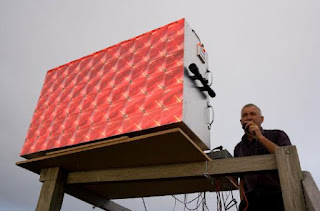 |
| The 60 LED TX array courtesy: REAST |
Earlier long-haul tests out to 209 km used the digital JT65 mode for signal decodes but the 288 km test used a fairly esoteric weak signal mode called WSC built on the Spectrum Lab software. This mode is capable of digging almost 20 db deeper into the noise than JT65, down to almost -50db.
An in depth description of the two long-haul events, including equipment schematics, can be found in "288 km Cloudbounce from Tasmania to the Australian Mainland" and in "209 km with Narrow Beamwidth Transmitter".
The 288 km crossing project evolved over several years and is all very well documented, from the first early steps, at the Radio and Electronics Association of Southern Tasmania's (REAST) website here.
This adventuresome project was largely the work of VK7MO, VK7JG, VK3HZ and VK7TW. Their work is most inspiring and much can be learned from seeing what they discovered when transmitting into the cloudy nighttime skies.
Such an endeavour as this makes the local, much shorter Georgia Strait crossing, seem like a cake-walk, but I can't imagine using anything that big and bright here without causing trouble ... it would probably appear much too 'laser-like' to talk one's way out of a jam. Pointing anything resembling a laser light into the air these days is simply begging for trouble.
I can however, envision a scaled-down version, perhaps consisting of an array of four Luxeons ... at least on my end of the path, but even pointing one of those from the city could be problematic. Perhaps any NLOS lightwave attempts across Georgia Strait will need to be well away from Vancouver and its two-million sets of eyes.
 VE7CNF’s Lightwave Cloubounce / Scatter Tests
VE7CNF’s Lightwave Cloubounce / Scatter Tests

After our recent lightwave CW QSO, described here, Toby (VE7CNF) has been re-focusing on refining his lightwave system for weak signal non-line-of-sight (NLOS) cloudbounce and scatter mode experiments.
His testing to date has been limited to within his own suburban yard, with the transmitter being set up on the south side of the house and the receiver set up on the north, while basically pointing things straight up.
Several tests have already been done with exciting results, including audible CW being returned from a low (5,000') cloud ceiling and weaker returns noted on clear air scatter but readily detected in the CW QRSS mode. Toby has also interfaced his PC audio, via amplifier and FET driver, to enable him to use WSPR and JT9 modes, resulting in positive signal returns using these two digital modes of modulation.
Toby described some of his results and methodology in a recent e-mail updater:
I've done some lightwave backscatter experiments this last week. The transmitter is on my front deck, pointed straight up as verified using a level across the lens end of the box. The receiver is in the back yard and pointed up also. Between the two, the house is about 30ft high and blocks any direct light.
Last night May 8 UTC was clear and I was getting a QRSS10 level signal with the receiver pointed at elevations from 70 to 85 degrees, through the transmitter beam. There was nothing received from straight up, so the clouds were too high for cloud backscatter. At 80 degrees elevation I got the best signal. I've attached an Argo screen grab of QRSS10 (FSK CW with the 570 Hz tone as key-down).
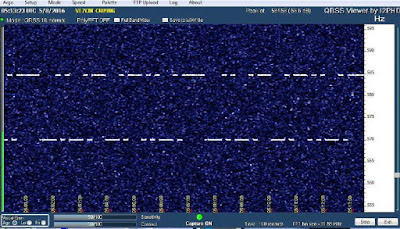 |
| QRSS10 CW clear air scatter return signal |
WSPR2 was decoding consistently and JT9 was about 70%. I tried JT65, BPSK31, and MFSK8 but the SNR was too low for those to work.
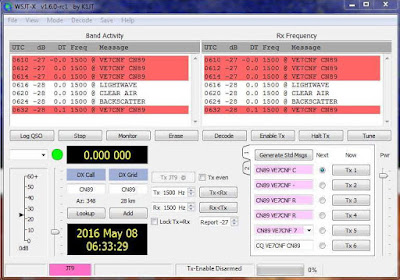 |
| JT9 cloudbounce return signal 14,000 - 24,000 FT |
May 8, 2016 UTC CYVR clouds and temperature/dewpoint data:
0500 FEW CLOUDS (1/8 - 2/8) 14000 FT, SCATTERED CLOUDS (3/8 - 4/8) 24000 FT, 14 C / 11 C
0600 FEW CLOUDS (1/8 - 2/8) 14000 FT, SCATTERED CLOUDS (3/8 - 4/8) 24000 FT, 14 C / 9 C
0700 FEW CLOUDS (1/8 - 2/8) 12000 FT, FEW CLOUDS (1/8 - 2/8) 22000 FT, 13 C / 7 C
... I'll try CW and digital again when there's some lower cloud conditions. That’s tough to get without rain at the same time.
I did get dew on the receiver last night, so I'll be adding heating resistors inside the boxes to keep the lenses warm. Electric heating has worked great to keep dew off the optical surfaces of my telescope. I'll also look at adding shrouds to shield the lenses from the cold sky.
More from May 15th:
Last night was good for backscatter from low clouds, at 1300 to 1900 ft according to airport weather. I had to stay up late though, as the cloud didn't move in until midnight.
I've attached a couple of CW recordings. Early on the signal was weaker with QSB. Later it was strong and solid.
I've also attached a screen grab of WSPR2. Signals were up around 0dB this time.
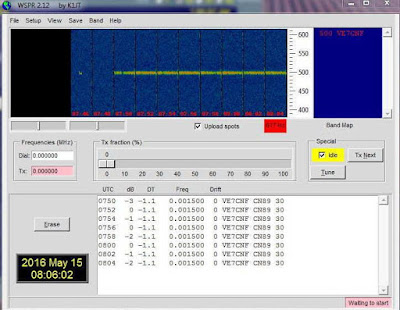 |
| WSPR cloudbounce return signals 1300 - 1900 FT |
I played with a bunch of digital modes and FMHELL and SSTV. Everything was working pretty well off the clouds.
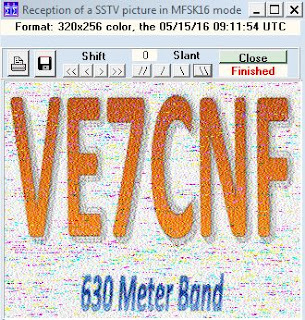 |
| SSTV cloudbounce return signal |
The nextstep is to move the rx farther from home, then to try sending signals over to John or Steve by cloud bounce.
Toby's nearest lightwave neighbour, VA7MM, is in mid-build and is working to complete a system capable of running overnight cloudbounce / scatter tests between their two respective backyards ... the NLOS distance is about 15 km. Although the path includes some bright commercial lighting QRM, with narrow-band modes such as QRSS or WSPR, it may not be a problem. I suspect one of the biggest problems will be getting suitable weather as, here on the west coast, dense clouds usually turn into rain very quickly, especially near the coastal mountains where Toby and Mark are located.
I find Toby's results to be both encouraging and exciting! It will be interesting to try some cloudbounce between their respective stations and my own and maybe hopping the NLOS path across cloudy Georgia Strait. It may well be possible to do this in one of the quicker QRSS CW modes such as QRSS3 or QRSS10, both of which can have fairly fast exchanges of the required information (calls, signal report and final confirmations). Failing that, slower QRSS30 or one of the weak signal digital modes such as JT9 / WSPR which have the ability to dig deep (-30db) into the background noise may be the answer ... there is much to learn yet!











